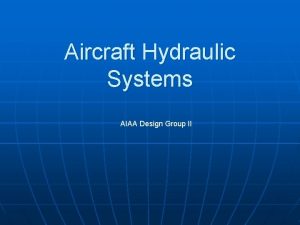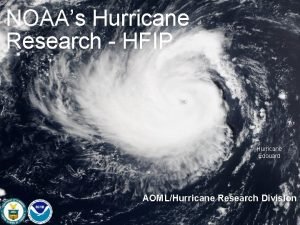Unmanned Aircraft Systems NOAAs Hurricane Unmanned Aircraft Systems


- Slides: 2

Unmanned Aircraft Systems NOAA’s Hurricane Unmanned Aircraft Systems Testbed The National Oceanic and Atmospheric Administration (NOAA) is working to use Unmanned Aircraft Systems (UAS) to improve its ability to monitor the global environment by filling critical gaps in our current measurement systems over remote and dangerous areas. NOAA’s UAS Project is establishing regional testbeds to evaluate the research and operational potential of the aircraft. The Problem Hurricanes and tropical storms cause many deaths and average billions of dollars in damages each year. In 2005, more than 1000 lives were lost in Hurricane Katrina alone, and the financial impact on the U. S. economy has already exceeded $200 Billion. In response, plans are underway to enforce mandatory evacuation of coastlines, including providing buses to allow nearly 100% of residents to leave when Category 4 or 5 storms are predicted to hit the coast. The cost of these mandatory evacuations, which could average as much as once yearly, will be in the billions of dollars. The stakes are high. Forecast errors in either direction are expensive. Money spent to improve the accuracy of hurricane prediction is a good investment. Improved forecasts and warnings have demonstrably saved lives and property. They also reduce the costs inherent in responding to the hurricane threat. The devastating impacts of Hurricanes like Katrina or Wilma (2005) require that we make the best possible and most authoritative information available to decision-makers to help them determine whether to implement mandatory evacuations and other costly actions for approaching hurricanes. Based on the current state of science and our operational system, we can expect generally good track predictions, but there are occasional substantial errors in intensity, particularly for rapidly intensifying or rapidly weakening storms. The extent of damage is determined by the size and structure of the storm. Even the track can sometimes be uncertain. Note the various model tracks forecast for Hurricane Rita as it approached the Gulf of Mexico (Fig. 1). Such a wide variation indicates room to improve tropical storm observations and models. No matter how good the models and forecasters are, the current poor state of offshore observing will result in occasional large misses in track and intensity in the 2 to 4 day forecasts. A NOAA is steadfastly working with its international and domestic partners to cost-effectively increase the number, breadth, accuracy, and availability of observing systems. As part of this effort, NOAA is investing in new technologies, such as UAS in order to number improve the accuracy and timeliness of our Nation’s existing weather observation and forecast system. Ultimately, the value of this proposed work will be measured in lives and money saved from improved understanding, forecasts and preparation. UAS Hurricane Prediction Improvements There are several operational and scientific issues that need to be addressed to improve hurricane intensity prediction. They include: Fig. 1 - Hurricane forecasters use “guidance” from models that are based on observations. If the models agree, they can make forecasts with high confidence. This guidance for “Rita” shows a high degree uncertainty. The cycle of eye-wall replacement. This cycle is widely recognized as a key determinant of hurricane intensity. It will never be well characterized by intermittent measurements - it will only be understood and predicted when we have the ability to continuously monitor the full

Unmanned Aircraft Systems monitor the full spatial and temporal structure of these cycles. The continuous monitoring of the storm inner structure that could be made with UAS could provide, in combination with satellites and other observing systems, the data needed to understand predict these cycles. Air-Sea Interaction. The interaction between the ocean and the hurricane is important, complex, and not well handled in current observing systems and models. This lack of understanding is primarily due to the limited availability of detailed observations within the storm near the air-sea interface. To this end, an enhanced system of ocean and coastal buoys in concert with an aggressive program to utilize low level UAS designed to penetrate and sample the violent low level hurricane environment would help fill this critical data void. Hurricane Environmental Interaction. The inner-core of a hurricane is a relatively small structure dependant upon the surrounding atmospheric environment to sustain its strength. To make a good severalday prediction, the winds, temperature and moisture structure of the air for a thousand plus mile radius around the storm are crucial determinants. A program that would use more manned and unmanned aircraft measurements in the large domain around the storm, and that would make more effective use of our satellite observing systems, could improve the intensity and track forecasts. Proposed Program The proposed coordinated strategy would use High-Altitude Long-Endurance (HALE) and Low-Altitude Long-Endurance (LALE) UAS to augment existing observational platforms (satellites, manned aircraft, in-situ observations). The United States has developed and currently deploys HALE-class UAS. An example is Northrop Grumman’s Global Hawk (Fig. 2). These aircraft have the advantage of being able to continuously monitor storms for long periods. A possible operations concept would be to deploy a HALE-class UAS at 60, 000 feet, well above the hurricane in the smooth clear air of the stratosphere, to take both remote and in-situ measurements to continuously monitor the storm intensity. Fig. 2. - Use of HALE-class UAS for high-altitude hurricane reconnaissance. (Mac. Donald and Surgi) These high-altitude measurements would be augmented by complementary low altitude missions that would utilize the unique attributes of LALE-class UAS such as the Aerosonde. Multiple low flying LALE-class UAS would be used to collect critical measurements very close to the ocean surface within the hurricane eye, eye-wall, and surrounding region (Fig. 3). (http: /uas. noaa. gov) Fig. 3. - Aerosonde (blue) and P-3 (red) flight tracks into tropical storm Ophelia on September 16, 2005. This mission marked the first ever successful unmanned flight into a tropical cyclone. Storm intensity at the time was 55 kts. Aerosonde flight altitude within the storm varied between 300 -800 m.



